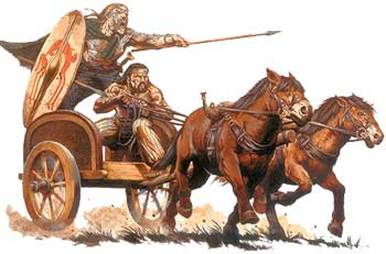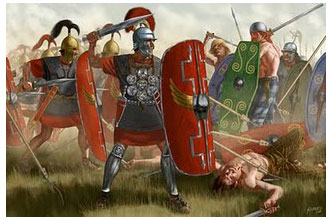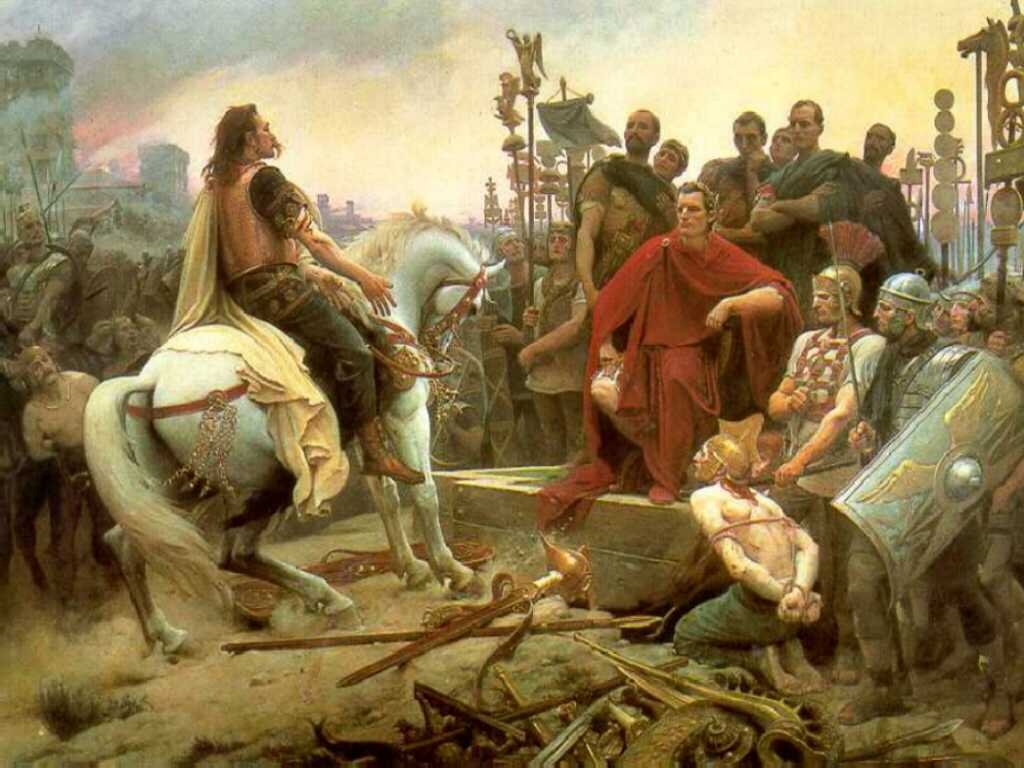Conflicts between Celts and classical civilisations:

390 BC - Gauls (celts) capture the city of Rome
' the time that Dionysius was besieging Rhegium, the Celts1 who had their homes in the regions beyond the Alps streamed through the passes in great strength and seized the territory that lay between the Apennine mountains and the Alps, expelling the Tyrrhenians who dwelt there. 2 These, according to some, were colonists from the twelve cities of Tyrrhenia; but others state that before the Trojan War Pelasgians fled from Thessaly to escape the flood of Deucalion's time and settled in this region. 3 Now it happened, when the Celts divided up the territory by tribes, that those known as the Sennones received the area which lay farthest from the mountains and along the sea. But since this region was scorching hot, they were distressed and eager to move; hence they armed their younger men and p305sent them out to seek a territory where they might settle. Now they invaded Tyrrhenia, and being in number some thirty thousand they sacked the territory of the Clusini.'
- Appian,Roman Hisrtory, IV, Diodorus Siculus, XIV, 113-14
279 BC -Galatians (tribe of celts) attack the Greek religious shrine at Delphi
'so they tried to save Greece in the way described, but the Gauls, now south of the Gates, cared not at all to capture the other towns, but were very eager to sack Delphi and the treasures of the god. They were opposed by the Delphians themselves and the Phocians of the cities around Parnassus; a force of Aetolians also joined the defenders, for the Aetolians at this time were pre-eminent for their vigorous activity. When the forces engaged, not only were thunderbolts and rocks broken off from Parnassus hurled against the Gauls, but terrible shapes as armed warriors haunted the foreigners. They say that two of them, Hyperochus and Amadocus, came from the Hyperboreans, and that the third was Pyrrhus son of Achilles. Because of this help in battle the Delphians sacrifice to Pyrrhus as to a hero, although formerly they held even his tomb in dishonor, as being that of an enemy'
- INVASION OF THE GAULS, HISTORY - PAUSANIAS 1. 1 - 16
225 BC - Gaesetae attack Italy and confront the romans at the Battle of Telamon
About forty thousand Celts were slain and at least ten thousand taken prisoners, among them the king Concolitanus. 2 The other king, Aneroëstes, escaped with a few followers to a certain place where he put an end to his life and to those of his friends. 3 The Roman Consul collected the spoils and sent them to Rome, returning the booty of the Gauls to the owners. 4 With his legions he traversed Liguria and invaded the territory of the Boii, from whence, after letting his legions pillage to their heart's content, he returned at their head in a few days to Rome. 5 He sent to ornament the Capitol the standards and necklaces (the gold necklets worn by the Gauls), 6 but the rest of the spoil and the prisoners he used for his entry into Rome and the adornment of his triumph.
- Polybius, the histories ii, 28 - 31
' the time that Dionysius was besieging Rhegium, the Celts1 who had their homes in the regions beyond the Alps streamed through the passes in great strength and seized the territory that lay between the Apennine mountains and the Alps, expelling the Tyrrhenians who dwelt there. 2 These, according to some, were colonists from the twelve cities of Tyrrhenia; but others state that before the Trojan War Pelasgians fled from Thessaly to escape the flood of Deucalion's time and settled in this region. 3 Now it happened, when the Celts divided up the territory by tribes, that those known as the Sennones received the area which lay farthest from the mountains and along the sea. But since this region was scorching hot, they were distressed and eager to move; hence they armed their younger men and p305sent them out to seek a territory where they might settle. Now they invaded Tyrrhenia, and being in number some thirty thousand they sacked the territory of the Clusini.'
- Appian,Roman Hisrtory, IV, Diodorus Siculus, XIV, 113-14
279 BC -Galatians (tribe of celts) attack the Greek religious shrine at Delphi
'so they tried to save Greece in the way described, but the Gauls, now south of the Gates, cared not at all to capture the other towns, but were very eager to sack Delphi and the treasures of the god. They were opposed by the Delphians themselves and the Phocians of the cities around Parnassus; a force of Aetolians also joined the defenders, for the Aetolians at this time were pre-eminent for their vigorous activity. When the forces engaged, not only were thunderbolts and rocks broken off from Parnassus hurled against the Gauls, but terrible shapes as armed warriors haunted the foreigners. They say that two of them, Hyperochus and Amadocus, came from the Hyperboreans, and that the third was Pyrrhus son of Achilles. Because of this help in battle the Delphians sacrifice to Pyrrhus as to a hero, although formerly they held even his tomb in dishonor, as being that of an enemy'
- INVASION OF THE GAULS, HISTORY - PAUSANIAS 1. 1 - 16
225 BC - Gaesetae attack Italy and confront the romans at the Battle of Telamon
About forty thousand Celts were slain and at least ten thousand taken prisoners, among them the king Concolitanus. 2 The other king, Aneroëstes, escaped with a few followers to a certain place where he put an end to his life and to those of his friends. 3 The Roman Consul collected the spoils and sent them to Rome, returning the booty of the Gauls to the owners. 4 With his legions he traversed Liguria and invaded the territory of the Boii, from whence, after letting his legions pillage to their heart's content, he returned at their head in a few days to Rome. 5 He sent to ornament the Capitol the standards and necklaces (the gold necklets worn by the Gauls), 6 but the rest of the spoil and the prisoners he used for his entry into Rome and the adornment of his triumph.
- Polybius, the histories ii, 28 - 31


